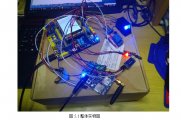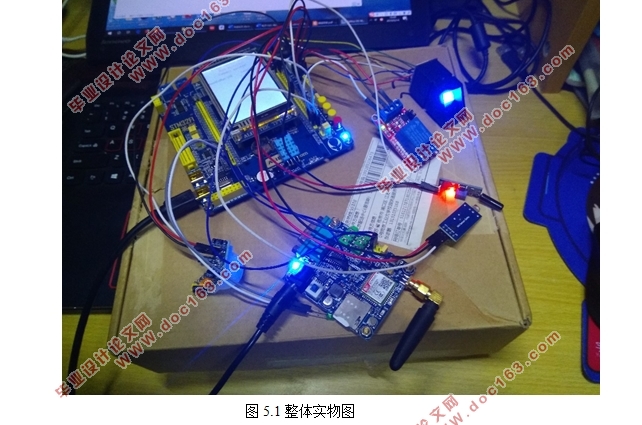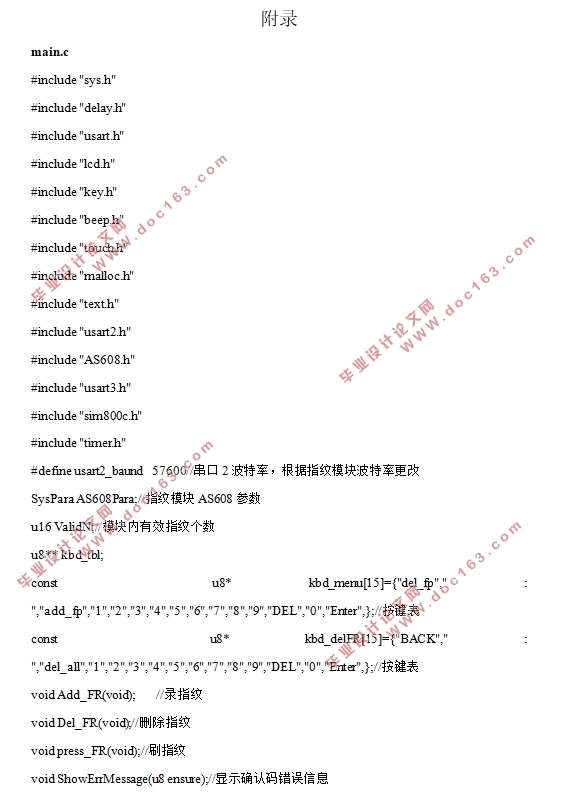基于指纹识别的门禁系统设计

基于指纹识别的门禁系统设计(任务书,开题报告,论文14000字)
摘要
生物识别技术是利用人的生物特征进行身份认证的技术,具有方便、安全、易管理特点。它可以细分为很多领域。其中指纹识别技术由于其价格低廉、易用性高的特点,在全球范围内被广泛应用在门禁系统中。
本论文旨在设计一个基于指纹识别的门禁系统。利用AS608指纹识别模块进行指纹的采集并且生成特征文件;使用TFTLCD电阻式触摸屏来进行门禁系统功能的控制与调节;分别通过继电器模块和蜂鸣器模块表示指纹验证通过和指纹验证失败或其他警告与提示信息;使用SW-1801P震动传感器模块来检测门禁的震动情况,通过其可调节模块上的可调电阻,为其设置一个合适的灵敏度;使用GSM模块作为报警模块,当震动传感器检测到震动异常时,向管理员发送报警短信或报警电话;利用光敏传感器和红外线传感器检测周围环境,结合两个模块设置一个合理的阀值来控制发光二极管的亮灭。最终实现包含报警功能的门禁系统。
关键词:指纹识别;门禁系统;单片机
Access control system based on fingerprint identification
ABSTRACT
The biometric technology of identity authentication based on human biological characteristics has the characteristics of convenience, safety and easy management. It is divided into many fields. Among them,fingerprint identification technology is widely used in access control system worldwide because of its low price and high usability. [资料来源:http://Doc163.com]
An access control system based on fingerprint recognition is designed in this paper. Firstly, fingerprints are collected by AS608 fingerprint recognition module and feature files are generated. Secondly, TFTLCD resistive touch screen is used to control the whole system. Relay module and buzzer module are used to display the identification results, including warning and prompt messages.Thirdly, the system vibration is detected by SW-1801P vibration sensor. The sliding rheostat of this module can adjust the sensitivity.Fourthly, the system uses GSM module to send alarm message or alarm telephone to administrator when the vibration of the system is abnormal.Fifthly, the photosensitive sensor and infrared sensor are used to detect the surrounding environment. A reasonable threshold is set in combination with the two modules to control the brightness and extinction of the light-emitting diode. Finally, the access control system including alarm function is realized.
Keyword:fingerprint identification;access control system;single chip microcomputer [来源:http://www.doc163.com]


目录
第一章绪论 1
1.1 研究背景和意义 1
1.2 研究现状与前景 1
1.3 论文结构 3
第二章系统的总体设计 4
2.1 设计方案 4
2.2 器件选择 4
2.2.1 指纹识别模块 5
2.2.2 单片机模块 6
2.2.3 触摸屏模块 7
2.2.4 继电器与蜂鸣器模块 7
2.2.5 报警模块 8
2.2.6 灯光控制模块 8
第三章系统的硬件设计 11
3.1 指纹模块电路 11
3.2 触摸屏模块电路 12
3.3 继电器与蜂鸣器模块电路 13
3.4 报警模块电路 13
3.5 灯光控制模块电路 14
第四章系统的软件设计 15
4.1 软件设计流程 15
4.2 程序整体设计流程 15
4.3 指纹识别功能软件设计 16
4.4 触摸屏功能软件设计 19
4.5 继电器与蜂鸣器功能软件设计 19
4.6 报警功能软件设计 20
4.7 灯光控制功能软件设计 21
第五章实验结果与系统调试 23
5.1 调试方案 23
5.2 系统调试过程 23
5.3 系统调试结果总结 26
5.4 问题反思 26
5.5 本章小结 27
第六章论文总结 28
参考文献 29 [来源:http://Doc163.com]
附录 31
致谢 46
